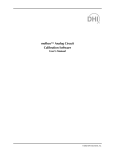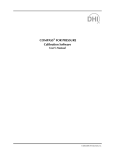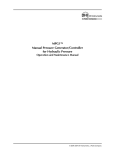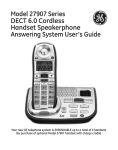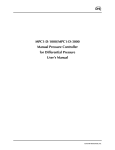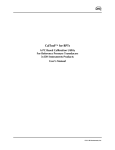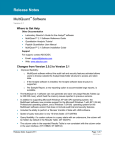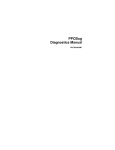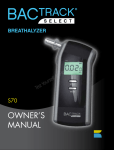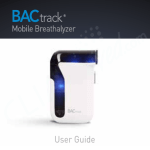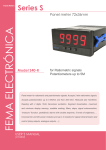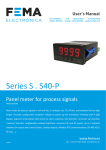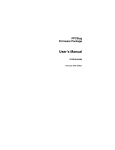Download PPC Communications Software User`s Manual
Transcript
PPC COMMUNICATIONS SOFTWARE User’s Manual ©2000 DH Instruments, Inc. PPC Communication Software User's Manual High pressure liquids and gases are potentially hazardous. Energy stored in these liquids and gases can be released unexpectedly and with extreme force. High pressure systems should be assembled and operated only by personnel who have been instructed in proper safety practices. © 1998 - 2000 DH Instruments, Inc. All rights reserved. Information in this document is subject to change without notice. No part of this document may be reproduced or transmitted in any form or by any means, electronic or mechanical, for any purpose, without the express written permission of DH Instruments, Inc. 4765 East Beautiful Lane Phoenix AZ 85044-5318 USA. DH Instruments makes sincere efforts to ensure accuracy and quality of its’ published materials; however, no warranty, expressed or implied, is provided. DH Instruments disclaims any responsibility or liability for any direct or indirect damages resulting from the use of the information in this manual or products described in it. Mention of any product does not constitute an endorsement by DH Instruments of that product. This manual was originally composed in English and was subsequently translated into other languages. The fidelity of the translation cannot be guaranteed. In case of conflict between the English version and other language versions, the English version predominates. DH Instruments, DH, and DHI are trademarks, registered and otherwise of DH Instruments, Inc. Document No. 550056a-01 000815 Printed in the USA. ©2000 DH Instruments, Inc. PPC Communication Software User's Manual TABLE OF CONTENTS TABLE OF CONTENTS ................................................................................ i TABLES .................................................................................................... ii FIGURES .................................................................................................. ii ABOUT THIS MANUAL .............................................................................. iv 1. INTRODUCTION .................................................................................... 1 1.1 1.2 OVERVIEW ................................................................................................................................................1 GETTING STARTED .................................................................................................................................1 1.2.1 1.2.2 1.2.3 1.2.4 OPERATION ......................................................................................................................................................2 PRESSURE GENERATION ...............................................................................................................................3 1.2.2.1 GENERATION MODE........................................................................................................................3 1.2.2.2 TARGET PRESSURE........................................................................................................................3 1.2.2.3 PRESSURE ARRAY ..........................................................................................................................4 REMOTE COMMAND ........................................................................................................................................4 GENERAL ..........................................................................................................................................................5 Page i ©2000 DH Instruments, Inc. PPC Communication Software User's Manual TABLES Table 1. Key Press Command List.......................................................................................................... 3 FIGURES Figure 1. PPC Communication Terminal Screen...................................................................................... 2 ©2000 DH Instruments, Inc. Page ii PPC Communication Software User's Manual NOTES Page iii ©2000 DH Instruments, Inc. PPC Communication Software User's Manual ABOUT THIS MANUAL Manual Conventions (CAUTION) is used in throughout the manual to identify user warnings and cautions. (NOTE) is used throughout the manual to identify operating and applications advice and additional explanations. [ ] indicates direct function keys (e.g., [RANGE]). < > indicates PG7000 screen displays (e.g., <1yes>). ©2000 DH Instruments, Inc. Page iv PPC Communication Software User's Manual 1. I NTRODUCTION 1.1 OVERVIEW With your PPC, you received a software CD with PPC communications software. These programs are intended to make it easy for you to get familiar with your PPC using any PC compatible computer. There are three programs on the disk: • TERMINAL: Will transform your computer into a terminal to work with the PPC. It is a useful program when first learning about your PPC and its operation. Further information on using the terminal program is given below. The TERMINAL.EXE program is intended to be used as an interactive communication link between the PPC and a host computer. This program handles all the proper protocol to assure communication between the PPC and the host computer with very little operator intervention. The source code is also included and can be used as a guide for writing your own application software. • I/O: An elementary program allowing you to send single commands to the PPC and read back its response. • SAMPLE: Sample of a typical PPC initialization and the beginning of an automated sequence. This program is listed in the manual. 1.2 GETTING STARTED To initiate the program, type TERMINAL at the DOS prompt. The host computer can communicate to the PPC through the following ports: COM1, COM2 and an IEEE-488 interface. The first screen will prompt you for the interface you would like to use. COM1 or COM2 or IEEE can be selected by pressing <1>, <2> or <3> respectively. For IEEE communications, the TERMINAL program assumes that an IEEE interface card PC-488 from CAPITAL EQUIPMENT CORPORATION (CEC: 617-273-1818) has been installed in the host computer. The terminal program will not work with any other IEEE-488 interface card. Page 1 ©2000 DH Instruments, Inc. PPC Communication Software User's Manual After the interface selection has been made, the terminal program will search for the PPC. If one of the serial interfaces is selected as the communication port, the terminal program will search for the PPC at different baud rates from 9 600 to 300. If the IEEE interface is selected, the program will first ensure that an IEEE card is installed in the computer, then search all available addresses from 1 to 30 attempting to establish communications with the PPC. Once the program locates the PPC, the remote light on the PPC will come ON and the screen should fill with the returned data. The terminal program will now be monitoring the current pressure in the PPC. If communication with the PPC is not established, check your RS232 cable pin-outs. If your PPC has an IEEE interface, be sure that the interface selector switch on the back of the PPC is set to the proper position. 1.2.1 OPERATION The top part of the screen contains the most common parameters used for pressure generation. See Figure 1. These parameters can be easily changed by pressing the appropriate highlighted key and entering the required data. The actual data is the only parameter that has to be entered. The terminal program will send out the corresponding command in the proper format. When setting any of these parameters, a message will be displayed in the current pressure window to indicate what is being changed. Table 1 lists these parameters along with the related KEY PRESS and the actual command that it corresponds to. PPC COMMUNICATIONS TERMINAL Copyright DH INSTRUMENTS Range Device Hold Vacuum : : : : 6000 psi PPC 25.000 No Version 3.00 April 1995 Interface : Target Max P Target Pressure : 0.000 psi current pressure : R Generation Mode : Static Remote command reply : : : : 0.050 6000.000 Stability Units * : 0.120 : psi - pressure Array - -1.560 psi min pres. max pres. : : Hold Off # of Inc. Ret to a. dwell : : : Execute status: Idle Continue baud: 2400 <ESC> to EXIT Figure 1. PPC Communication Terminal Screen ©2000 DH Instruments, Inc. COM1 Page 2 PPC Communication Software User's Manual Table 1. Key Press Command List KEY PRESS [D] [H] [T] [S] [V] [M] [N] [U] PURPOSE DEVICE HOLD TARGET STABILITY VACUUM MAX P RANGE UNITS RELATED COMMAND DEVICE= HS= TS= SS= VAC= UL= RANGE= UNIT= If the DEVICE is changed, then the other parameters are also updated. The TERMINAL program uses the standard PPC remote commands. For further information on specific commands, please refer to the proper PPC operating manual. The middle part of the screen is used for pressure monitoring and pressure generation. 1.2.2 PRESSURE GENERATION 1.2.2.1 GENERATION MODE The GENERATION MODE can be set by simply pressing [G]. A menu will be displayed giving you the option to select either <Static> or <Dynamic>. If the static mode is selected, another option will be displayed to determine whether the pressure hold is ON or OFF. <Hold ON> refers to setting the pressure with the PS command which just sets the pressure. <Hold OFF> refers to setting the pressure with the PSH command which sets and holds the pressure. In dynamic mode, the target limit is automatically set to zero and the pressure hold is always ON, so no selection is necessary. 1.2.2.2 TARGET PRESSURE The TARGET PRESSURE can be set by pressing [P]. When a new value is entered, that value becomes the target pressure and a pressure generation to the next target value will take place. The current pressure generation mode and hold state will determine how the pressure is generation and maintained. Pressing [ESC] during a pressure generation procedure will abort the function. The pressure generation time is monitored and displayed at the bottom of the screen. This is the time in seconds required to reach a ready condition. Page 3 ©2000 DH Instruments, Inc. PPC Communication Software User's Manual 1.2.2.3 PRESSURE ARRAY The pressure array is intended to be used to generate a sequence of pressures in a specific order. The pressures will be generated using with PS or PSH. This is determined by the Generation setting. To set up an array, press [A]. • min press: MINIMUM PRESSURE is the first pressure that is to be generated. It may also be the last pressure to be generated if return to start is set to YES. No limit checking is provided on the minimum or the maximum pressure so care must be taken to ensure that these values are in the normal operating range of the PPC. • max press: MAXIMUM PRESSURE is the highest pressure in the sequence that the PPC is to generate. • # of inc: NUMBER OF INCREMENTS is the number of pressure steps that the PPC will generate between the minimum and the maximum pressure. • ret to s: RETURN TO START determines if the PPC will return to the minimum pressure after reaching the maximum pressure. If this is set to NO, then the pressure array will stop executing after the maximum pressure has been reached. If this is set to YES, then after the maximum pressure has been reached, the pressure array will continue to generate the same pressures but in the opposite direction until the minimum pressure has again been reached. • dwell: DWELL is the delay in seconds that the PPC will remain at each pressure increment after a ready condition has occurred. After a ready indicator is received, then this delay will be executed before the next pressure will be generated. If a delay of 0 (zero) is entered, then the next pressure generation will not begin until the [C] key has been pressed. This allows you to stay at a pressure for as long as you like and continue when you are ready. Once a pressure array has been set up, it can be executed by pressing [F]. 1.2.3 REMOTE COMMAND The remote command can be used to send any command to the PPC. When using the remote command < -- REMOTE COMMAND -- > will be displayed in the current pressure window. See the PPC1 Operating Manual for a list of the remote commands available. Pressing [ESC] will return you to the pressure monitoring mode. ©2000 DH Instruments, Inc. Page 4 PPC Communication Software User's Manual 1.2.4 GENERAL The terminal program contains automatic error checking. The PPC will return an error whenever it receives an invalid command. The terminal program monitors all incoming responses from the PPC and when an error is received, will request the cause of the error. The returned error response is then displayed at the bottom of the screen. The keyboard input is not interrupt driven and may seem to lag behind a key press at certain times. This is normal due to the structure of the program. All function and key presses are picked up in a simple run-time loop. To return to DOS from the terminal program, press [ESC] from the pressure generation mode. Page 5 ©2000 DH Instruments, Inc. PPC Communication Software User's Manual NOTES ©2000 DH Instruments, Inc. Page 6












